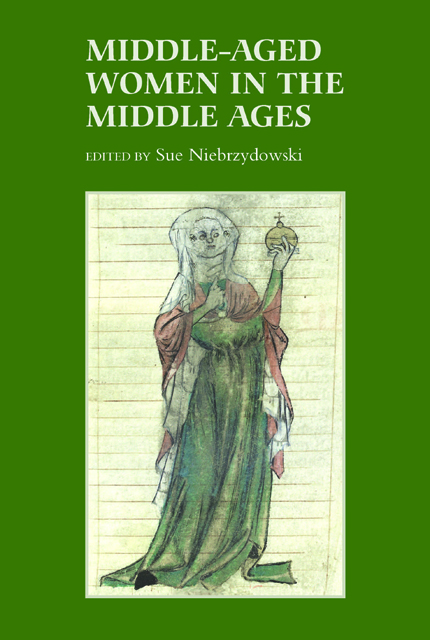Book contents
- Frontmatter
- Contents
- List of Plates
- Abbreviations
- Contributors
- Introduction: ‘Becoming bene-straw’: The Middle-Aged Woman in the Middle Ages
- 1 The Age of Discretion: Women at Forty and Beyond
- 2 Seeking the Middle-Aged Woman in Medieval Wales
- 3 Middle Age in Romance? Magic, Enchantment and Female Power
- 4 Age and Desire in the Old English Life of St Mary of Egypt: A Queerer Time and Place?
- 5 The St Albans Psalter: Sex, Desire and the Middle-Aged Woman
- 6 Speaking Volumes: the Middle-Aged Woman and the Book in Medieval England
- 7 ‘Late hir seye what sche wyl’: Older Women’s Speech and the Book of Margery Kempe
- 8 Preparing for Mature Years: the Case of Margaret of Anjou and her Books
- Select Bibliography
- Index
Introduction: ‘Becoming bene-straw’: The Middle-Aged Woman in the Middle Ages
Published online by Cambridge University Press: 14 February 2023
- Frontmatter
- Contents
- List of Plates
- Abbreviations
- Contributors
- Introduction: ‘Becoming bene-straw’: The Middle-Aged Woman in the Middle Ages
- 1 The Age of Discretion: Women at Forty and Beyond
- 2 Seeking the Middle-Aged Woman in Medieval Wales
- 3 Middle Age in Romance? Magic, Enchantment and Female Power
- 4 Age and Desire in the Old English Life of St Mary of Egypt: A Queerer Time and Place?
- 5 The St Albans Psalter: Sex, Desire and the Middle-Aged Woman
- 6 Speaking Volumes: the Middle-Aged Woman and the Book in Medieval England
- 7 ‘Late hir seye what sche wyl’: Older Women’s Speech and the Book of Margery Kempe
- 8 Preparing for Mature Years: the Case of Margaret of Anjou and her Books
- Select Bibliography
- Index
Summary
In The Merchant’s Tale Januarie stipulates that his ideal bride will be no more than twenty years old, and that he especially ‘wol no woman of thritty yeer of age; / It is but bene-straw and greet forage’ (Merchant’s Tale, 1421–2). Januarie wants an heir and his dismissal of a more mature woman as an unsuitable spouse is based upon a perceived connection between a woman’s age, fecundity and sexual attraction. The Middle English Dictionary defines benestraw as ‘the refuse of broad bean plants (the stalks and empty pods)’ and ‘forage’ as dry fodder fit only for animal consumption. According to Januarie, by thirty a woman is an ‘oold wyf’ (1416) and his insulting comparison of her to ‘bene-straw’ suggests that she has become an infertile husk, a mummifying memory of her former youthful bloom, a delicacy now only to horses and cattle.
Infertility is only one facet of the insult that Januarie hurls at the older woman. Not only does she lack the sexual allure of youth but also she may turn into a shrew, as acid-tongued as the caustic lye made by mixing the ashes from burning ‘benestraw’ with water. Further, Januarie perceives the older woman to be too worldly-wise (1423) and hence intractable – so set in her ways that she cannot be moulded by her husband’s guidance as a young wife would and should be (1429– 30). The irony of Januarie’s insult is never lost on female readers since it is made by a sixty-year-old with ‘slake skyn aboute his nekke’ (1849), and whose sexual performance is ‘nat … worth a bene’ (1854) (or possibly benestraw?) to his young wife. Nor can readers easily overlook his failure to recognise the double standard at work here – he is very conscious of age withering a woman’s physical charm and allure yet believes himself impervious to the ageing process, ‘I feel me nowhere hoor but on myn heed’ (1464). Januarie’s definition of when a woman is old and his attitude towards women’s ageing, stemming as it does from his characterisation as a mal-marié senex amans of fabliau tradition, is, nonetheless, a useful starting point for an examination of women’s middle age in the Middle Ages.
- Type
- Chapter
- Information
- Middle-Aged Women in the Middle Ages , pp. 1 - 14Publisher: Boydell & BrewerPrint publication year: 2011
- 1
- Cited by



